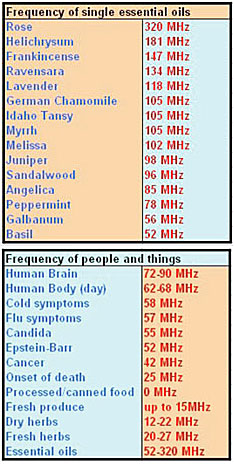the Science ~ the Rose Frequency
In 1992, Bruce Tainio of Tainio Technology, a division of Eastern Washington State University, Cheney, WA, developed equipment to measure electrical frequency in humans and foods. This equipment was used in a research study at Johns Hopkins University to determine the relationships between frequency and diseases.
The results of that study are as follows:

More results from the studies:
While holding a cup of coffee, one participant's frequency dropped from 66 MHz to 58 MHz (-8 MHz). Another participant drank the coffee, his frequency dropped from 66 MHz to 52 MHz (-14 MHz). After inhaling an essential oil of 75 MHz or higher, their frequency returned to normal in less than one minute.
While holding a cigarette another subject's frequency dropped from 65 MHz to 48 MHz (-17 MHz); smoking the cigarette, his frequency dropped to
42 MHz (-23 MHz), the same frequency as cancer.
Essential oils in the higher frequency ranges tend to influence the emotions.
Essential oils in the lower frequencies have more effect on structural and physical changes, including cells, hormones, and bones, as well as viruses, bacteria, and fungi.
Essential oils do not resonate with the toxins in our bodies.
This incompatibility is what helps eliminate the toxins from our systems.
Essential oils also do not resonate with negative emotions.
Allowing us a greater opportunity to release them.